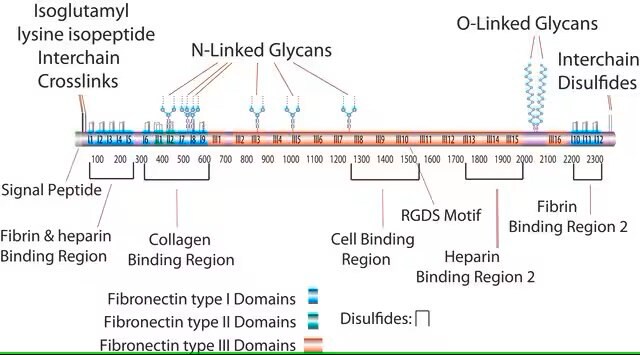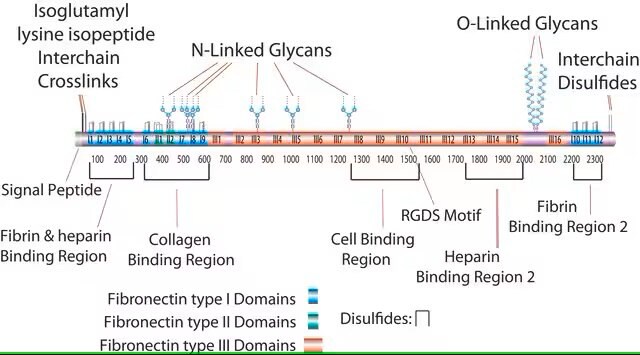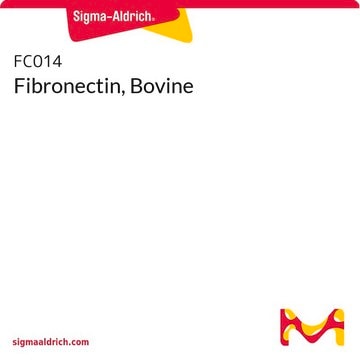The concentration of the 0.1% solution can be found in the Certificate of Analysis. To calculate micrograms per square centimeter, consider the volume used and the surface area of the well.
F0895
Human Fibronectin
from human plasma, liquid, 1 mg/mL, suitable for cell culture
Synonim(y):
Fibronectin
Wybierz wielkość
1430,00 zł
Wybierz wielkość
About This Item
1430,00 zł
Polecane produkty
Nazwa produktu
FIBRONECTIN FROM HUMAN PLASMA, liquid, 0.1% (Solution), BioReagent, suitable for cell culture
pochodzenie biologiczne
human plasma
Poziom jakości
sterylność
sterile
linia produktu
BioReagent
Formularz
liquid
opakowanie
pkg of 1 mg
pkg of 2 mg
pkg of 5 mg
stężenie
0.1% (Solution)
metody
cell culture | mammalian: suitable
pokrycie powierzchni
1‑5 μg/cm2
rozpuszczalność
saline: 0.05 M (Tris-buffered)
numer dostępu UniProt
Specyficzność wiązania
Peptide Source: Collagen
Warunki transportu
wet ice
temp. przechowywania
2-8°C
informacje o genach
human ... FN1(2335)
Szukasz podobnych produktów? Odwiedź Przewodnik dotyczący porównywania produktów
Opis ogólny
FN occurs as a dimeric protein, linked by two disulfide bonds at the end of C-terminal.[2] Within the fibronectin structure, the domains are compactly arranged close to both the amino and carboxyl terminal of the peptide chains.[3] Moreover, it has been observed that despite arising from a single gene up to 20 distinct variants of this gene have been identified in humans.[2]
Zastosowanie
Działania biochem./fizjol.
Cechy i korzyści
- Adhesive glycoprotein
- Derived from human plasma
- Recommended surface coverage of 1-5 μg/cm2
Uwaga dotycząca przygotowania
In coating culture surfaces, fibronectin should be diluted in sterile balanced sterile salt solution and coated with minimal volume. Surface should then be air dried for 45 minutes at room temp and can be stored for 2-4 weeks at 2-8°C
Komentarz do analizy
Informacje prawne
Oświadczenie o zrzeczeniu się odpowiedzialności
produkt powiązany
Kod klasy składowania
12 - Non Combustible Liquids
Klasa zagrożenia wodnego (WGK)
WGK 1
Temperatura zapłonu (°F)
Not applicable
Temperatura zapłonu (°C)
Not applicable
Wybierz jedną z najnowszych wersji:
Certyfikaty analizy (CoA)
Nie widzisz odpowiedniej wersji?
Jeśli potrzebujesz konkretnej wersji, możesz wyszukać konkretny certyfikat według numeru partii lub serii.
Masz już ten produkt?
Dokumenty związane z niedawno zakupionymi produktami zostały zamieszczone w Bibliotece dokumentów.
Klienci oglądali również te produkty
Produkty
Fibronectin (FN) plays crucial roles in extracellular matrix fibril assembly and cellular interactions.
Fibronektyna (FN) odgrywa kluczową rolę w tworzeniu fibryli macierzy zewnątrzkomórkowej i interakcjach komórkowych.
Organoidy płuc są cennymi modelami 3D dla rozwoju ludzkich płuc i chorób układu oddechowego. Protokół różnicowania 3dGRO™ generuje organoidy z ludzkich iPSC w 4 krokach.
Lung organoids are valuable 3D models for human lung development and respiratory diseases. The 3dGRO™ differentiation protocol generates organoids from human iPSCs in 4 steps.
Protokoły
Rozcieńczona fibronektyna do mocowania komórek, w zależności od typu komórek. Protokół powlekania, produkty i często zadawane pytania.
Dilute fibronectin for cell attachment, varying per cell type. Coating protocol, products, and FAQs provided.
-
How many µg/cm² would the coating concentration be if I applied a coating with a 0.1% concentration using the F0895 product?
1 answer-
Helpful?
-
-
What is the recommended storage duration for Fibronectin (F0895) at 4°C, -20°C, and -80°C? How long can a diluted solution of 10ug/mL in PBS be stored at 4°C? Is it possible to reuse the Fibronectin solution to coat culture ware surfaces multiple times?
1 answer-
The recommended storage duration for Fibronectin (F0895) is up to 1 year at 4°C. There has been no testing done on its stability after storage at -80°C or -20°C. A diluted solution of 10ug/mL in PBS can be stored at 4°C for 2-4 weeks. However, the solution cannot be reused to coat culture ware surfaces multiple times; the recommended process involves coating surfaces with a minimal volume, allowing them to air dry for 45 minutes at room temperature, and then storing the cultureware at 4°C for 2-4 weeks.
Helpful?
-
-
What is the recommended dilution rate for coating the culture surface with F0895-1MG Fibronectin as per the preparation instructions?
1 answer-
The recommended dilution rate for coating the culture surface with F0895-1MG Fibronectin, as per the preparation instructions, is to start with a concentration in the range of 1 - 5 ug/cm^2. For a 96-well plate well with a surface area of about 0.34 cm^2, approximately 2 ul of F0895 further diluted in saline with a total volume of around 50 ul would be sufficient to cover the bottom of the well.
Helpful?
-
-
How should I store and handle Product F0895, Fibronectin from human plasma?
1 answer-
Recommended storage of this material is 2-8 °C. Vortexing, excessive agitation, repeated freezing and thawing of reconstituted fibronectin are not recommended.
Helpful?
-
-
What is the Department of Transportation shipping information for this product?
1 answer-
Transportation information can be found in Section 14 of the product's (M)SDS.To access the shipping information for this material, use the link on the product detail page for the product.
Helpful?
-
-
What is the solvent for Product F0895, Fibronectin from human plasma?
1 answer-
This material is solubilized in a 0.05 M Tris-buffered saline, pH 7.5.
Helpful?
-
-
How much Product F0895, Fibronectin from human plasma, do I use for my application?
1 answer-
Recommended for use as a cell culture substratum at 1-5 μg/cm2 or 0.5-50 μg/mL. Optimal concentration depends on cell type as well as the application or research objectives.
Helpful?
-
-
Is Product F0895, Fibronectin from human plasma, sterile?
1 answer-
Fibronectin 0.1% solution is a sterile product. It is tested for sterility. The sterility test results can be found on the lot-specific certificate of analysis.
Helpful?
-
Active Filters
Nasz zespół naukowców ma doświadczenie we wszystkich obszarach badań, w tym w naukach przyrodniczych, materiałoznawstwie, syntezie chemicznej, chromatografii, analityce i wielu innych dziedzinach.
Skontaktuj się z zespołem ds. pomocy technicznej









